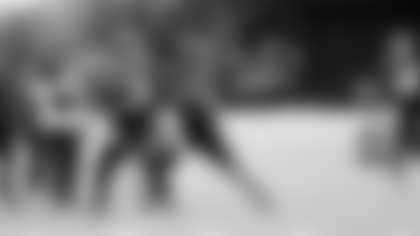John McClain, a member of the Pro Football Hall of Fame and the Texas Sports Hall of Fame, is in his 48th year of covering the NFL in Houston, including 45 seasons at the Houston Chronicle.
The first time I saw Andre Johnson was during the 2001 season when Miami played at Florida State.
Johnson, a Miami native, was a sophomore wide receiver for the Hurricanes who would catch 37 passes for 682 yards (18.4-yard average) and 10 touchdowns that sophomore season in which they would finish 12-0 and win the national championship under Head Coach Larry Coker, their first since 1991.
I liked to channel surf on Saturdays, and I tried not to miss games between the Hurricanes and Seminoles because of the bitter rivalry they'd developed through the years. Their rosters were always loaded with players who would become first-round draft choices, and both teams played an exciting brand of offense that featured spectacular play a lot of scoring. There was nothing boring about the Hurricanes or Seminoles.
On that afternoon in Tallahassee, Miami blistered Florida State 49-27. Johnson caught five passes for 111 yards (22.2 average) and two touchdowns from quarterback Ken Dorsey.
The Hurricanes had so many exceptional players it was hard to keep up with their extraordinary talent at almost every position but quarterback. Dorsey, who's in his first season as Cleveland's offensive coordinator after getting fired by Buffalo last season, was an outstanding college quarterback who was blessed with outstanding receivers – the best being Andre Johnson.
That period was the zenith of Miami football. The Hurricanes had become a perennial contender for the national title. They had an almost endless supply of talent no matter who coached them – Howard Schnellenberger, Jimmy Johnson, Dennis Erickson, Butch Davis or Larry Coker.
And Johnson became one of the greatest Miami receivers, ranked right up there with Michael Irvin, the standard for Hurricane receivers who won three Super Bowl rings with the Cowboys.
The next time I really focused on a Miami game was the 2002 Rose Bowl. The Hurricanes needed to defeat Nebraska to win the national championship. They blew out the Huskers, leading 34-0 in the second quarter and coasting to a 37-14 victory.
Johnson had the best game of his college career under the pressure of a national title being at stake. He and Dorsey collaborated on seven catches for 199 yards and touchdowns of 49 and 8 yards.
In 2002, when Johnson was preparing for his last season at Miami, the Texans were having their inaugural draft. General Manager Charley Casserly selected Fresno State quarterback David Carr. He was supposed to be the franchise quarterback they would build their offense around for Head Coach Dom Capers.
The Texans liked Johnson before they ever acknowledged being interested in him. And why not? In his last season at Miami, he caught 52 passes for 1,092 yards (21 average) and nine touchdowns. He helped the Hurricanes finish 12-1, with the only loss against Ohio State in the Fiesta Bowl. That defeat cost them back-to-back national championships.
Casserly, Capers and Owner Bob McNair knew if they used the third pick in the first round on Johnson, they'd be getting a 6-3, 229-pound receiver who ran the 40-yard dash in the 4.3s. Johnson had a rare combination of size and speed. And he was a winner. In his three seasons with the Hurricanes, his teams combined for a 35-2 record and finished second, first and second in the country. It was the most prolific three-year stretch in Hurricane history.
The more Casserly and Capers watched Johnson, the more they liked him. He was a physical receiver who liked to block. He didn't back down from defensive players. He had a tremendous work ethic. They were especially impressed with the way he played in big games.
For instance, in 2002 against nationally ranked Virginia Tech, Miami won 56-45. Johnson caught six passes for 193 yards (32.2 average) and a touchdown. He helped Miami score at least 40 points eight times and close with a 40.5-point average that season.
Like Casserly and Capers, McNair was excited about the possibility of adding Johnson as Carr's go-to receiver, but the Texans had to sweat the first two picks.
Cincinnati had the first pick, and it was no secret the Bengals were going to take quarterback Carson Palmer, the Heisman Trophy winner from USC. Then it became sketchy. Detroit had the second pick, and the Lions wanted a big-play receiver, just like the Texans. There was pressure for them to select Michigan State's Charles Rogers and keep him at home.
Rogers was so incredible as a junior for the Spartans that he was recognized as the best receiver in the nation, winning the Biletnikoff Award and being voted as a consensus All-American. Rogers had 68 catches for 1,351 yards and 13 touchdowns. The NFL extended him an invitation to attend the draft in New York. Johnson wasn't invited.
McNair talked privately about how much the Texans liked and wanted Johnson. He was worried about the Lions, but Casserly had done his homework and assured McNair that Rogers was going second. Casserly was confident there was no way Detroit would pass up the home-grown Rogers.
Johnson's character was impeccable. Rogers had a lot of off-the-field issues in college, but the Lions overlooked them.
Before I did my mock draft for the Houston Chronicle, I asked Casserly if I should still pencil in Johnson for the Texans? He said, "Yes." I asked, "But what if the Lions take Johnson?" He said, "They won't." I asked, "But if they do, would he take Rogers?" He said, "Absolutely not." And Casserly was right about everything.
Casserly was confident Johnson would be available, and he was. Palmer went first and Rogers second. It took the Texans about two seconds to draft Johnson.
Rogers became one of the biggest busts in NFL history. He had injury and drug issues. He played three seasons and was out of football. He finished with nine starts, 36 catches, 440 yards and four touchdowns. He was 38 when he died in 2019 after battling cancer and needing a liver transplant.
As for Johnson, well, you know the rest of the story. His career wasn't too shabby. He played 14 seasons, including 12 with the Texans, and compiled 1,062 catches for 14,185 yards and 70 touchdowns. He's been a terrific ambassador for the Texans and the NFL on and off the field. He was the first player to join McNair in the team's Ring of Honor at NRG Stadium.
Johnson became one of the greatest receivers in league history. That's why on Saturday afternoon in Canton, Ohio, his extraordinary career will be recognized with his induction into the Pro Football Hall of Fame, where he'll proudly wear his Gold Jacket during his acceptance speech and be cheered by thousands of Texans' fans who'll be there to honor him.
"Andre going into the Hall of Fame means everything to our organization," Head Coach DeMeco Ryans said this week. "Every person that's worked in this organization, every player who's strapped it up and put on that Texans jersey, Andre is representing everyone. And there's no better guy than Andre to be the first Houston Texan going in as a Hall of Famer."
Johnson was playing in his fourth season when Ryans was a rookie linebacker in 2006. They played six seasons together. Ryans will have his coaches and players in Canton to watch Johnson's induction.
"He's always been the best player on any field he's stepped on," Ryans said. "And he's been great man in the community and a great leader, as well. We're happy to be there to support Andre as the first Texan to be inducted into the Hall of Fame."















